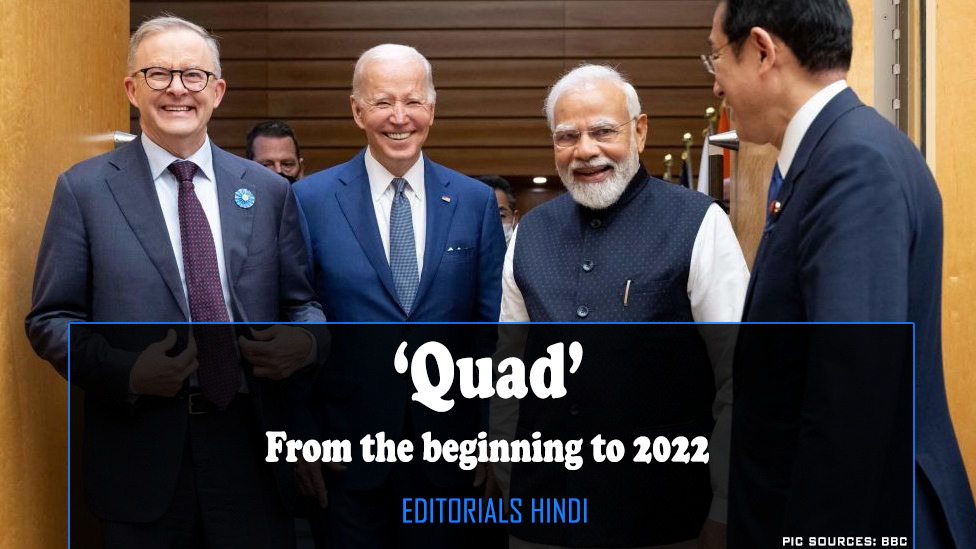From the beginning to 2022
As the name suggests, Quad is a Quadrilateral Security Dialogue between the four nations, viz. Japan, India, the US, and Australia, first came into light as a loose partnership during the Indian Ocean tsunami of 2004, in which all these countries provide disaster relief and humanitarian assistance to the affected region. The Quad was later formalized by the Japanese Premier Shinzo Abe but later ceased to operate after the withdrawal of both Australia and the new Premier of Japan.
The Quad was loosely revived after Shinzo Abe again became the Premier but it was fully recognized during the ASEAN summits of 2017 in Manila, as Quad 2.0, to counter mainly China’s increasing hegemony in the Asia-Pacific region, through military and diplomatic strategies to be used in the Indo-Pacific region, which became a serious issue for its member nations.
For India, which mostly uses soft power in its foreign diplomacy sees Quad as an alternative means through which it can check the irritating action by China, like border region disputes, dumping of raw materials at a cheaper rate, and more importantly trying to bitter the ties between India and its neighboring countries-Nepal, Pakistan, Sri Lanka, Bhutan, by them the prey of its economic and infrastructure assistance to these countries.
Australia, on the other hand, saw no risks regarding trading in the Indo-Pacific region and at the same time, interested in stronger relations with China because it sees China as a simple growing economy in the region till the “Hu Jintao” regime but later after Xi, its belief Shaked by the aggressive expansionist approach of the country in its neighborhood as well as in the highly profitable region of the seas- the SCS (South China Sea). The belief of Australia in Quad can be very well seen from the fact, that the newly elected PM Anthony Albanese, soon after taking the oath, rushed to attend the Quad summit 2022 in Tokyo on 24th May.
Japan, from the very beginning, focused on a way to contain China’s growing power in the Indo-Pacific through various maritime exercises with other countries, which later in 2017 became the reality, Quad 2.0. This will help Japan to have a say in the region with respect to free trade and fishing opportunities for the people of its country.
It is very well established since past centuries, that a powerful state wants to remain powerful at any cost, whether using its soft power-signing mutual agreements, ties, memorandums, etc., or harsh power-using military, creating civil war and chaos within the society of other states, etc., here comes the United States of America. The US being the superpower, it seems very necessary for it to strengthen the Quad 2.0 to check the growing presence of China in the Indo-Pacific. Thus, it is keenly interested in naval & military exercises with the member countries individually and together as well, as the recent Malabar Naval Exercise.
Quad, which was earlier described by China as a “froth in the sea” is currently a well-established and more serious security partnership of the four nations. China sees Quad 2.0 as a containment strategy for itself to start a new cold war era and to check its territorial expansion in its neighboring regions like Taiwan; Tibet; Arunachal Pradesh, Ladakh, and POK of India; as well as economic expansion in the countries like Pakistan, Sri Lanka, Myanmar, Bhutan, etc., through its giant projects.
The focus area of the Quad members is the South China Sea (SCS) and the 9 dash lines made by China to show its ownership right on the whole SCS region. The region being a very strategic region in terms of trade, minerals, fishing, shipping, etc., provides huge employment to more than 3 million people of neighboring countries. In 2015, the SCS region accounts for 12% of global fish catch, which will further increase if China’s harsh presence is not there. Being a super shipping region, it accounts for 1/3rd of global shipping worth trillions of dollars pushing through it. More importantly in 2019, the US State Department found more than USD 2.5 trillion worth of untapped oil & gas reserves in the region.
Since the 19th century, it’s a trend that a great economy builds a great empire. Consider if China establishes its ownership over the SCS region, then it may become the next superpower as it will charge others for using the region for doing any activity, providing itself with huge economic benefits. But correspondingly, it will affect other countries regarding free & secured trade, restrictions on millions of fish catchers, etc.,
The Quad summit 2022 conclusively holds that there should be a free, open, and inclusive Indo-Pacific region which is the common goal of Quad 2.0. During the Covid-19 pandemic, vaccine delivery, climate action, supply chain resilience, disaster response, and economic assistance among the Quad members increased much. Thus, Quad is trying to maintain peace, progress, prosperity, and stability in the Indo-Pacific region as a “Force for Good”.
Akshay Kumar Sharma
Editor: Editorials in Hindi
Kindly Refer to https://editorialshindi.in website for more such informative articles.
(The opinions and thoughts expressed in this article solely reflect the author’s personal views and discretion.)

